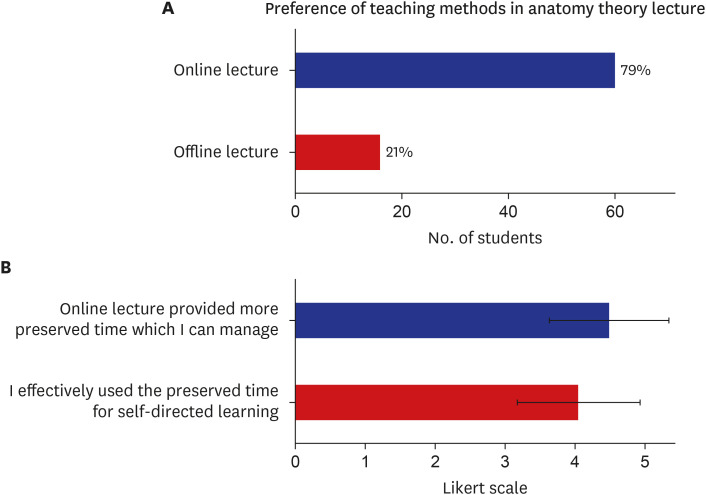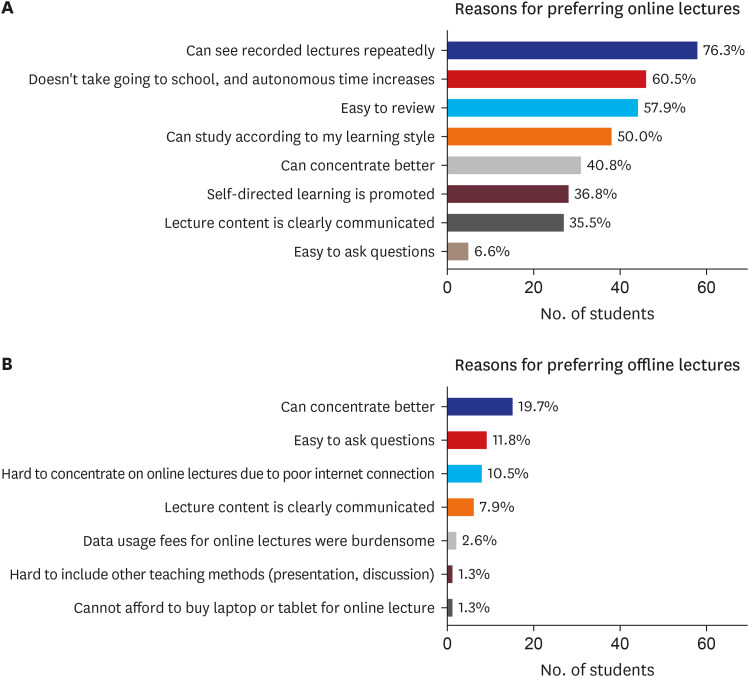J Korean Med Sci.
2021 Jan;36(1):e13. 10.3346/jkms.2021.36.e13.
Adaptations in Anatomy Education during COVID-19
- Affiliations
-
- 1Department of Anatomy, Korea University College of Medicine, Seoul, Korea
- 2Practical Anatomy Research Institute, Korea University, Seoul, Korea
- 3Department of Medial Education, Korea University College of Medicine, Seoul, Korea
- 4Department of Biomedical Sciences, Brain Korea 21 FOUR, Korea University College of Medicine, Seoul, Korea
- KMID: 2510381
- DOI: http://doi.org/10.3346/jkms.2021.36.e13
Abstract
- Background
The impact of coronavirus disease 2019 (COVID-19) has profoundly affected education, with most universities changing face-to-face classes to online formats. To adapt to the COVID-19 pandemic situation, we adopted a blended learning approach to anatomy instruction that included online lectures, pre-recorded laboratory dissection videos, and 3D anatomy applications, with condensed offline cadaver dissection.
Methods
We aimed to examine the learning outcomes of a newly adopted anatomy educational approach by 1) comparing academic achievement between the blended learning group (the 2020 class, 108 students) and the traditional classroom learning group (the 2019 class, 104 students), and 2) an online questionnaire survey on student preference on the learning method and reasons of preference.
Results
The average anatomy examination scores of the 2020 class, who took online lectures and blended dissection laboratories, were significantly higher than those of the 2019 class, who participated in an offline lecture and dissection laboratories. The questionnaire survey revealed that students preferred online lectures over traditional large group lecture-based teaching because it allowed them to acquire increased self-study time, study according to their individual learning styles, and repeatedly review lecture videos.
Conclusion
This study suggests that a blended learning approach is an effective method for anatomy learning, and the advantage may result from increased self-directed study through online learning.
Figure
Cited by 1 articles
-
Lessons from Cadaver Dissection during the COVID-19 Pandemic
Dasom Kim, Hyeijung Yoo, Young-Mee Lee, Im Joo Rhyu
J Korean Med Sci. 2021;36(26):e188. doi: 10.3346/jkms.2021.36.e188.
Reference
-
1. Nicola M, Alsafi Z, Sohrabi C, Kerwan A, Al-Jabir A, Iosifidis C, et al. The socio-economic implications of the coronavirus pandemic (COVID-19): a review. Int J Surg. 2020; 78:185–193. PMID: 32305533.
Article2. UNESCO. Education: From disruption to recovery. Updated 2020. https://en.unesco.org/covid19/educationresponse.3. Rose S. Medical student education in the time of COVID-19. JAMA. 2020; 323(21):2131–2132. PMID: 32232420.
Article4. Brassett C, Cosker T, Davies DC, Dockery P, Gillingwater TH, Lee TC, et al. COVID-19 and anatomy: stimulus and initial response. J Anat. 2020; 237(3):393–403. PMID: 32628795.
Article5. Byrnes KG, Kiely PA, Dunne CP, McDermott KW, Coffey JC. Communication, collaboration and contagion: “Virtualisation” of anatomy during COVID-19. Clin Anat. 2021; 34(1):82–89. PMID: 32648289.6. Iwanaga J, Loukas M, Dumont AS, Tubbs RS. A review of anatomy education during and after the COVID-19 pandemic: revisiting traditional and modern methods to achieve future innovation. Clin Anat. 2021; 34(1):108–114. PMID: 32681805.7. Evans DJ, Bay BH, Wilson TD, Smith CF, Lachman N, Pawlina W. Going virtual to support anatomy education: a STOPGAP in the midst of the Covid-19 Pandemic. Anat Sci Educ. 2020; 13(3):279–283. PMID: 32277598.
Article8. Ministry of Health and Welfare. COVID-19 Government Countermeasures Meeting Briefing. Sejong: Ministry of Health and Welfare;2020.9. Kim KJ, Bonk CJ, Oh E. The present and future state of blended learning in workplace learning settings in the United States. Perform Improv. 2008; 47(8):5–16.
Article10. Dziuban C, Graham CR, Moskal PD, Norberg A, Sicilia N. Blended learning: the new normal and emerging technologies. Int J Educ Technol High Educ. 2018; 15(1):3.
Article11. Pereira JA, Pleguezuelos E, Merí A, Molina-Ros A, Molina-Tomás MC, Masdeu C. Effectiveness of using blended learning strategies for teaching and learning human anatomy. Med Educ. 2007; 41(2):189–195. PMID: 17269953.
Article12. Green RA, Whitburn LY. Impact of introduction of blended learning in gross anatomy on student outcomes. Anat Sci Educ. 2016; 9(5):422–430. PMID: 26929149.
Article13. Beale EG, Tarwater PM, Lee VH. A retrospective look at replacing face-to-face embryology instruction with online lectures in a human anatomy course. Anat Sci Educ. 2014; 7(3):234–241. PMID: 23959807.
Article14. Attardi SM, Barbeau ML, Rogers KA. Improving online interactions: lessons from an online anatomy course with a laboratory for undergraduate students. Anat Sci Educ. 2018; 11(6):592–604. PMID: 29493909.
Article15. Swinnerton BJ, Morris NP, Hotchkiss S, Pickering JD. The integration of an anatomy massive open online course (MOOC) into a medical anatomy curriculum. Anat Sci Educ. 2017; 10(1):53–67. PMID: 27315160.
Article16. Topping DB. Gross anatomy videos: student satisfaction, usage, and effect on student performance in a condensed curriculum. Anat Sci Educ. 2014; 7(4):273–279. PMID: 24106107.
Article17. Saltarelli AJ, Roseth CJ, Saltarelli WA. Human cadavers vs. multimedia simulation: a study of student learning in anatomy. Anat Sci Educ. 2014; 7(5):331–339. PMID: 24415563.
Article18. Attardi SM, Rogers KA. Design and implementation of an online systemic human anatomy course with laboratory. Anat Sci Educ. 2015; 8(1):53–62. PMID: 24920278.
Article19. Mathiowetz V, Yu CH, Quake-Rapp C. Comparison of a gross anatomy laboratory to online anatomy software for teaching anatomy. Anat Sci Educ. 2016; 9(1):52–59. PMID: 25903289.
Article20. Trelease RB. From chalkboard, slides, and paper to e-learning: How computing technologies have transformed anatomical sciences education. Anat Sci Educ. 2016; 9(6):583–602. PMID: 27163170.
Article21. Kwon K, Park JS, Shin BS. Virtual anatomical and endoscopic exploration method of internal human body for training simulator. J Korean Med Sci. 2020; 35(12):e90. PMID: 32233159.
Article22. Kwon K, Chung MS, Park JS, Shin BS, Chung BS. Improved software to browse the serial medical images for learning. J Korean Med Sci. 2017; 32(7):1195–1201. PMID: 28581279.
Article23. Funk SC, Dickson KL. Multiple-choice and short-answer exam performance in a college classroom. Teach Psychol. 2011; 38(4):273–277.
Article24. Wilkinson T, Shaw H. Are spot test multiple choice questions easier to answer than short answer questions? FASEB J. 2015; 29(Suppl 1):344.1.25. Nieder GL, Borges NJ. An eight-year study of online lecture use in a medical gross anatomy and embryology course. Anat Sci Educ. 2012; 5(6):311–320. PMID: 22674561.
Article26. Sugand K, Abrahams P, Khurana A. The anatomy of anatomy: a review for its modernization. Anat Sci Educ. 2010; 3(2):83–93. PMID: 20205265.
Article27. Hu M, Wattchow D, de Fontgalland D. From ancient to avant-garde: a review of traditional and modern multimodal approaches to surgical anatomy education. ANZ J Surg. 2018; 88(3):146–151. PMID: 28922705.
Article28. Franchi T. The impact of the Covid-19 pandemic on current anatomy education and future careers: a student's perspective. Anat Sci Educ. 2020; 13(3):312–315. PMID: 32301588.
Article29. Jeyakumar A, Dissanayake B, Dissabandara L. Dissection in the modern medical curriculum: an exploration into student perception and adaptions for the future. Anat Sci Educ. 2020; 13(3):366–380. PMID: 31168930.
Article30. Lachman N, Pawlina W. Integrating professionalism in early medical education: the theory and application of reflective practice in the anatomy curriculum. Clin Anat. 2006; 19(5):456–460. PMID: 16683241.
Article31. Chang HJ, Kim HJ, Rhyu IJ, Lee YM, Uhm CS. Emotional experiences of medical students during cadaver dissection and the role of memorial ceremonies: a qualitative study. BMC Med Educ. 2018; 18(1):255. PMID: 30419880.
Article32. D Souza A, Kotian SR, Pandey AK, Rao P, Kalthur SG. Cadaver as a first teacher: A module to learn the ethics and values of cadaveric dissection. J Taibah Univ Med Sci. 2020; 15(2):94–101. PMID: 32368204.
Article33. Charlton R, Dovey SM, Jones DG, Blunt A. Effects of cadaver dissection on the attitudes of medical students. Med Educ. 1994; 28(4):290–295. PMID: 7861999.
Article34. Pearson S. Anatomy: beyond the COVID-19 pandemic. Acad Med. 2020; 95(11):e1.
Article35. Al-Riyami S, Moles DR, Leeson R, Cunningham SJ. Comparison of the instructional efficacy of an internet-based temporomandibular joint (TMJ) tutorial with a traditional seminar. Br Dent J. 2010; 209(11):571–576. PMID: 21151070.
Article36. IMD World Competitiveness Center. IMD world digital competitiveness ranking 2019. Updated 2019. https://www.imd.org/wcc/world-competitiveness-center-rankings/world-digital-competitiveness-rankings-2019/.37. Moore MG. Editorial: three types of interaction. Am J Distance Educ. 1989; 3(2):1–7.
Article38. Rhim HC, Han H. Teaching online: foundational concepts of online learning and practical guidelines. Korean J Med Educ. 2020; 32(3):175–183. PMID: 32894921.
Article39. Jaffar AA. Exploring the use of a Facebook page in anatomy education. Anat Sci Educ. 2014; 7(3):199–208. PMID: 24022984.
Article
- Full Text Links
- Actions
-
Cited
- CITED
-
- Close
- Share
- Similar articles
-
- Dividing Medical Students into Two Groups for Cadaver Lab under COVID-19 Situation
- Comparison between Pre-recorded Anatomy Lecture and Real-time Online Anatomy Lecture
- Online educational methods vs. traditional teaching of anatomy during the COVID-19 pandemic
- Students’ Response to Anatomy Practice in era of the COVID-19 Pandemic
- The development and effects of a COVID-19 nursing education program for nursing students



